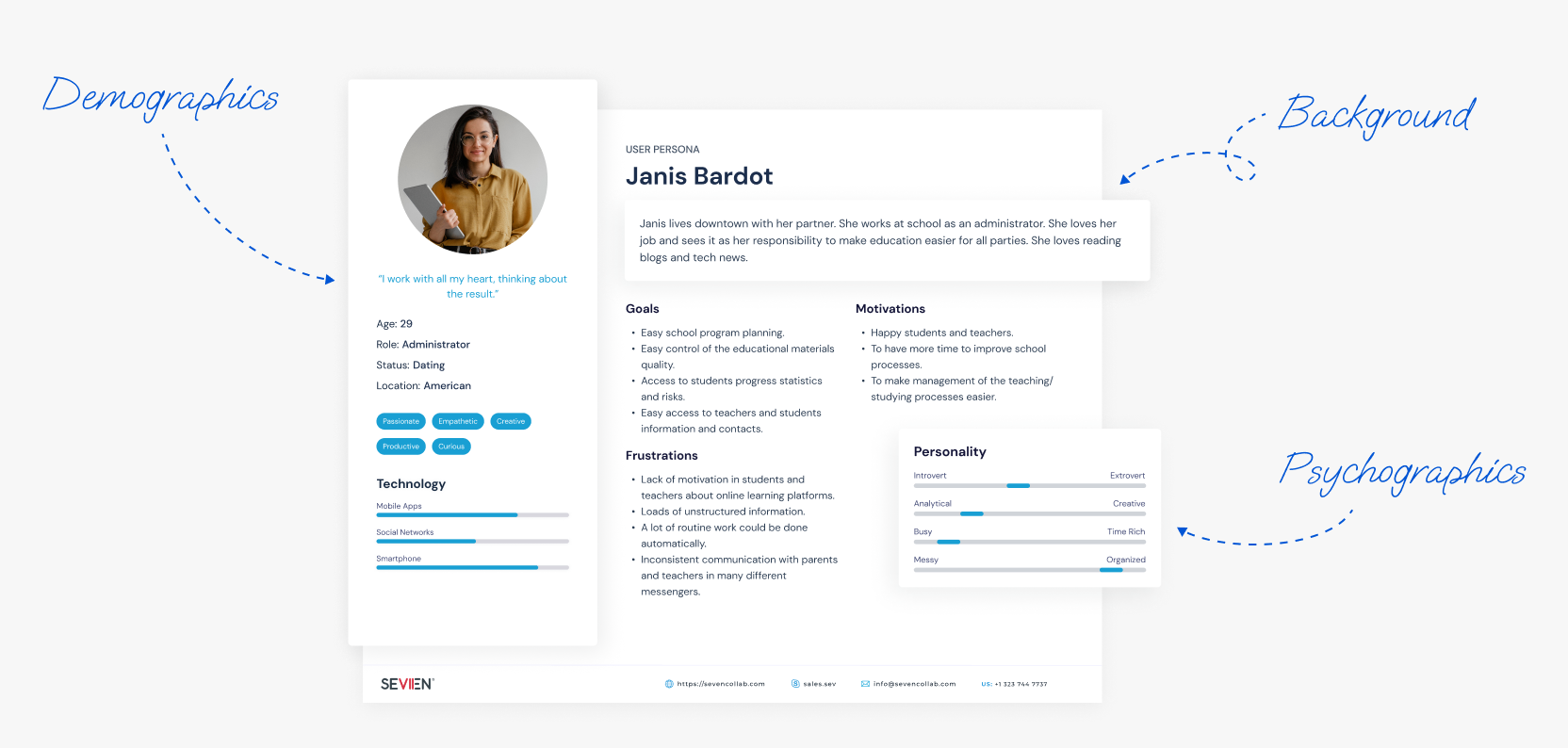There is one universal challenge for anyone building a product for the market: knowing the target audience and fixing their problems. Scoring this match with the users is vital to the product’s success.
You can have software, idea, marketing of a record high quality. But the users may not like it anyway. Just because it doesn’t align with their values or isn’t exactly what they’ve hoped for. We believe that a good software prototype can boost the chances of success massively. And the research and discovery are crucial parts of the process, including the research on your target audience. This is where user personas become useful.
What are User Personas?
They are fictional characters based on real examples of your target audience. Each persona is the protagonist of the story. They help to look deeper and discover each user’s needs, problems, and cravings.
The main idea is to combine research and creativity into a number of profiles that serve as a representation of your users. This way, you can focus on their needs more thoroughly, delivering a result that is much more likely to hit close to home. User personas are often the next step from empathy mapping – generating a broad idea of what users think, feel, do, and say.
What’s inside each Persona?
You can deviate from the following checklist in any way you see fit based on your business goals. But here’s what you’ll find in pretty much every User Persona.
1. Name
Make sure you come up with a realistic name for your persona. Naming the profile “Dummy 2” will only make you consider it a dummy, not an actual persona that represents your user.
2. Demographics
Age, gender, occupation, income, location – everything that can give life to a persona. More realistic details mean better representation and, thus, a bigger impact on the product.
3. Motivation to use your product
If you’re building a mobile bookstore, ask yourself – why would that person use your service? Now’s the time to think as your users think.
4. Pain points
Also known as frustrations, these describe the issues that the customer faces. Does it take too long to find a book? How frustrated are they while trying to filter through thousands of items? Frustrations can be anything, as long as they are connected to the business and you can solve them.
5. Goals
What is the user’s goal in connection to your product? Are they buying a book because they want to start reading again? Or maybe they’re researching something health-related, and all their activity revolves around it. Goals help determine the best approach for each customer.
6. Personality
Add some uniqueness to each persona. This can be a personal motto, behavior patterns, brand, or celebrity preferences. These give your persona more life and help you imagine a real person behind all the data.

How to create the best possible User Persona?
While we’ve given you a checklist of items, it’s not enough to get all the kinks right. Here are some good practices to help you get the information and to apply it more efficiently during the product design phase.
Use real data
You might have noticed that personas have a lot to do with creativity and fiction. And the only way to make it all meaningful and useful for your case is to apply the data from a real target audience. User feedback, including user persona creation, is a huge part of the research and prototyping phase.
You can conduct a quick survey to see who your users are. What do they do, why are they interested in your services, what prevents them from using the said service right now, etc. This will give you a clear idea of goals, motivation, and frustrations. Empathy mapping is a great place to start with research and data collection, which in turn can be sufficient for creating a Customer Journey Map.
Identify trends
The next step is to make sense of all the data you’ve acquired. Determine the key areas you want to research. If a certain problem (for example, people stop using online bookstores because the filter doesn’t work as they like it) becomes prevalent in the answers, there’s your trend. And a conclusion that the product will gain favor for eliminating the issue.
Define scenarios and behavior
Combining the personas and different scenarios is the first step towards creating a user flow with use cases. Come up with different patterns each user might follow while browsing the bookstore. Do they need to find a specific book? Are they just hunting for bargains?
Trace the process from the user’s perspective and see what roadblocks they might encounter. Do it again in a different scenario and see where your product is lacking.
Don’t create too many Personas
You may be tempted to go all in and create a separate persona for each scenario. But after a certain number, the personas will get repetitive and lose uniqueness and usefulness.
You can extract enough value with just one persona backed by research and feedback from the team members across departments. If you feel like exploring other personas with unique specifics, make sure you designate one of them as a priority. This way, you will not lose focus on the main goal while remaining aware of other possibilities.
The Takeaway
User Persona is a fictional profile that describes your potential user. Their goals, fears, problems, demographics – everything that can help you provide a better service and a better product.
While making a persona requires a lot of brainstorming and creativity, the end result is meaningless if you do not build it on top of real survey data from your target audience. Focus on unique personalities and behavior patterns. This way, you’ll be able to track the user’s progress and to define strong and weak points.